CAN YOU SALVAGE A FREEZER BURNED, FREEZER DRIED HIDE?
by Glen Conley of WHITETAIL DESIGNER SYSTEMS
HOW LONG IN THE FREEZER?
CAN IT STILL BE GOOD?
CAPE WITH BAD FREEZER BURN, CAN ANYTHING BE DONE?
CAN YOU SALVAGE A FREEZER BURNED, FREEZER DRIED HIDE?
The above questions are what we have all heard in the past, or, we may have even inadvertently brought on such conditions ourselves, then we are asking the same questions.
The below STOP-ROT case history will be hard to top. Cape in freezer since 1984, still good?
May of 2003, Mike Baker of Raw Liver Creek Taxidermy called me up and asked, "Hey, have you got anything for freezer burn? I got a mule deer cape out of Montana and it is BAD!"
The first thing that went through my mind was Hard Tissue Tonic, that works well on freezer burned areas if it has some "good" skin surrounding the freezer burn.
Mike continued, "I've got it thawed out and I can't even get the thing to open up. It's been in the freezer for AT LEAST seven to ten years. It's a big cape and I'd like to be able to save it. If I can get it mounted up, I can use the taxidermy work for partial payment on my elk hunt this fall." The cape belonged to an outfitter.
That ruled out Hard Tissue Tonic. I told him, "Yeah, I got some stuff here that works pretty good on freezer burn. I'll swing up after while and bring you some and take a look at what you've got." Mike is only about ten miles away.
I get there and he shows me this "thing" he was calling a cape. It smelled and looked like smashed out road kill on hot pavement. Mike's comment was, "I told ya it was bad."
It was something of a combination of freezer burn and freeze dried. It did still contain some moisture. I had my doubts. Mike had a whole lot more doubts than I did.
I'm always saying, "You don't know until you try." I had to say that to Mike, and with that we started brushing on the STOP-ROT.
The old musty "dead" smell was gone within minutes of brushing on the STOP-ROT. We could see the STOP-ROT "working" on the skin. I only had about 8-10 ounces of STOP-ROT left on hand for myself, which is what I took to Mike. It only takes 3-5 ounces for most deer capes.
This cape had been "rough" skinned at best. There were a lot of meat hunks left on it. Trying to treat the dried out meat and skin was about the equivalent of trying to paint over dry rotted wood. The STOP-ROT I had brought with me was enough to cover, but it looked like as if it wasn't going to be enough to get the cape to relax the rest of the way.
We realized at that point that we should have been photographing this as a "Before", but photos would not have done this mess justice. How would you photograph odor? I would have to think that would be like trying to catch a fart and paint it green.
In about twenty minutes the cape had softened up enough where it could just about be opened up, but we had ran out of STOP-ROT. We knew at that point we might be looking at possibilities. It would be the following day before I could pick up any more STOP-ROT.
Now we were in this quandry as to what to do until the next day. I told him as to what had been done in the way of experimentation and what turned out positive results. I also told him what areas HAD NOT been explored, but should work.
I pointed out that STOP-ROT could be cut to SOME degree with DISTILLED water (I was also real quick to point out he should NOT use his well water for this one), but it was pretty fool proof the way it was.
The question was, with the obvious display that we had seen, had the STOP-ROT
already done it's job? And would this cape stand up to the amount of rehydration it was going to take?
Mike is an official member of the Older Than Dirt Gang, and kidding him about having a hard time giving up lead earliners has always been one of my favorite things to do. He really surprised me when he went the unexplored option. Ya gotta remember, there's an elk hunt riding on this too!
Mike reported, "I went to town and got 3 gallons of distilled water and let the cape soak overnight."
"Did you use any more STOP-ROT?", I asked.
He replied, "I just added more to the soak solution, can't remember how much, and let it sit overnight again." Kidding him about the fact that they tore down the high school building that his class graduated from, right after they graduated, has always been another one of my favorite things to do.
Mike continues, "The next day I turned the ears, split the lips, worked the eyes and nose and fleshed. Then I froze it for three days, thawed, and salted dry. I've been doing this stuff for thirty years, and if I hadn't of seen it, I wouldn't have believed it."
You may be wondering why Mike froze the cape for three days, and thawed again. Real simple, Mike was the first person to get the report from me, quite some time back, that the working qualities of a skin could be improved by a STOP-ROT application and then freezing. I brush a coat of STOP-ROT on the flesh side of every skin before I put it in the freezer. I'm starting to suspicion that the same thing should be done with the epidermis around the eyes and the ears.
Back to Mike's experience. Mike shipped the cape off to Carolina Fur Dressing.
In the absence of the cape, we still discussed the odds of it being salvageable. It
was my belief that if it made it through the neutralizing process, it was down hill. In the mean time, he was able to find out the year the cape had been put in the freezer.
The mule deer had been taken in 1984..........
August 11 th., 2003, the cape is back from Carolina Fur dressing. Was it salvaged?
Is Mike going to be able to use taxidermy work against the cost of his elk hunt?
Check out these photos!
These two photos give you a general view of what the cape looked like right out of the box from Carolina Fur Dressing. That is one good looking cape, isn't it!?
These next three shots were the first areas I had to get my paws on and get a look. I was expecting the epidermis to be gone, history, wiped out, nada, around the eye and the lips. I was expecting to see no nodules left on the nose pad. By rights, they should have been gone! That long in the freezer, that length of time in water to rehydrate, then to go through neutralization after acid, AND THEN those big tumblers, the epidermis and nodules have to be gone! Check out that epidermis around the eyes and the lacrimal gland!
This is the same results that I had gotten from personal tanning experience with the WHITETAIL DESIGNER SYSTEMS on capes that SHOULD have slipped epidermis.
Through process of elimination, and observations from other customers, I can now see that it IS the STOP-ROT that is the big player.
Another potential problem area can be the epidermis around a bloody bullet wound. You don't have the advantage of having been able to see this wound before it was shipped to the tannery, but the wound area did not slough any additional epidermis.
Said Mike, "That cape came back as good as anything I sent in from last season. That bag had been busted open for no tellin's how long in that freezer. It was a nothing to lose, everything to gain situation."
The finished mule deer shoulder mount is to your right.
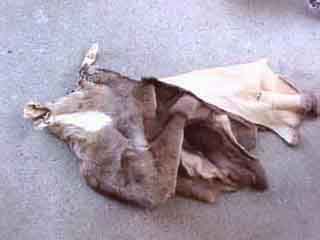
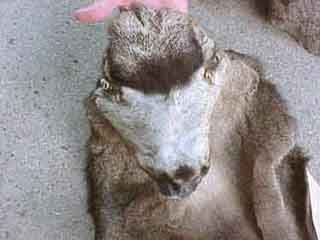
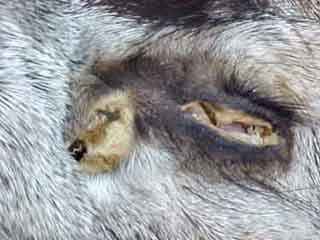
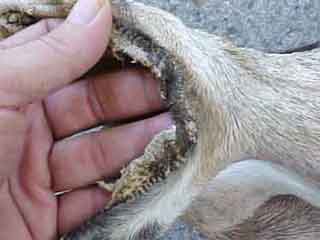
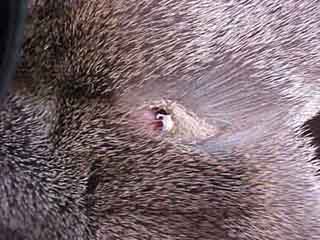

STOP-ROT is available from these taxidermy supply distributors and tanneries: Order on-line from high lighted suppliers!
RESEARCH MANNIKINS 1-800-826-0654
Van Dyke's Taxidermy Supply 1-800-843-3320
Wildlife Artist Supply Company 1-800-334-8012
Quality Taxidermy Supply 1-888-527-8722
AEWS Taxidermy Supplies 1-800-529-3470
Taxidermy Arts Supply TASCO
Lonestar Wool & Fur 1-919-989-2000
SIVKO FUR, INC. 1-607-698-4827
James Taxidermy Supply (formerly Kings)
1-662-286-5133
WHITETAIL DESIGNER SYSTEMS 1-866-849-9198